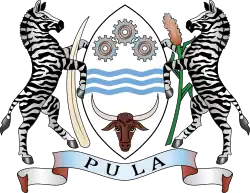Bogosi Act
The Bogosi Act is a piece of legislation in Botswana that defines the office of bogosi or "chieftainship" among Botswana's various tribes. The act was written in response to the Balopi Commission recommendation that the Constitution of Botswana replace all references of the word "chief" to the Setswana word kgosi. The Bogosi Act replaces the earlier Chieftainship Act of 1987.[1]
| Bogosi Act | |
|---|---|
| National Assembly of Botswana | |
| |
| Citation | CAP 41:01, Act 9 of 2008 |
| Territorial extent | Whole of Botswana |
| Enacted by | National Assembly of Botswana |
| Commenced | 30 April 2008 |
| White paper | Government White Paper No. 1 of 2001, Government White Paper No. 2 of 2002 |
| Legislative history | |
| Bill title | Bogosi Bill, No. 13 of 2007 |
| Committee report | Balopi Commission |
| Repeals | |
| Chieftainship Act | |
 |
|---|
| Constitution |
History
Outcry from minority tribes in Botswana such as the Wayeyi pushed President Festus Mogae to create the Balopi Commission on 28 July 2000 to investigate tribal discrimination. The commission found that the structure of the House of Chiefs of Botswana, later renamed Ntlo ya Dikgosi, "tended to be discriminatory".[2] In response, the Bogosi Bill was passed, creating the Bogosi Act.
Content
The Bogosi Act defines the institution of bogosi or tribal chieftainship. A kgosi (plural: dikgosi) is the tribal leader and has the following functions:
- to exercise his or her powers under this Act to promote the welfare of the members of his or her tribe;
- to carry out any lawful instructions given to him or her by the Minister;
- to convene kgotla meetings to obtain advice as to the exercise of his or her functions under this Act;
- to arrange tribal ceremonies;
- to preside over cases in terms of the warrant of his or her court issued under the Customary Courts Act; and
- to perform such other functions as may be conferred on him or her by or under this Act or any other enactment.[3]
The dikgosi of the eight main Batswana tribes automatically become members of the Ntlo ya Dikgosi, an advisory body to the Parliament of Botswana.
Reaction
The act has been criticised by tribal leaders because of the limitations on the powers of a kgosi.[4] In 2010, Kgosi Kgafela II of the Kgatla tribe was accused of flogging, but he argued that dikgosi have immunity to the state's jurisdiction. The Botswana High Court dismissed the case on 11 May 2011, claiming that "dikgosi cannot act outside the constitution and laws prescribed by Parliament when all other functionaries of the state act within the statutory limitations."[5] To avoid the legal costs of the case, Kgafela moved to Moruleng, South Africa.[6]
See also
References
- "Botswana - Bogosi Act (Chapter 41:01)". www.ilo.org. Retrieved 2020-05-29.
- Ray, Donald I.; Quinlan, Tim; Sharma, Keshav; Clarke, Tacita A.O., eds. (2011). "The Role of the House of Chiefs (Ntlo ya Dikgosi) in Botswana" (PDF). Reinventing African Chieftaincy in the Age of AIDS, Gender, Governance, and Development (PDF). Africa, Missing Voices. Vol. 8. Calgary: University of Calgary Press. hdl:1880/48426. ISBN 978-1-55238-537-1. ISSN 1703-1826. Archived (PDF) from the original on 9 February 2015. Retrieved 26 July 2012.
- Government of Botswana (30 April 2008). "Bogosi Act" (PDF). Archived from the original (PDF) on 3 March 2016. Retrieved 18 July 2012.
- Gabzfm (3 November 2011). "Dikgosi wants constitution to restore their powers". Archived from the original on 18 July 2012. Retrieved 18 July 2012.
- Gulbrandsen, Ørnulf (March 2012). The State and the Social: State Formation in Botswana and Its Pre-Colonial and Colonial Genealogies. New York City: Berghahn Books. p. 343. ISBN 9780857452979. LCCN 2011037469.
- Letswamotse, Phaladi (18 April 2012). "Kgafela is broke". The Botswana Gazette. Archived from the original on 2012-07-18. Retrieved 18 July 2012.
External links
- Full text of the Bogosi Act
- Chieftainship Act, the act that the Bogosi Act replaced